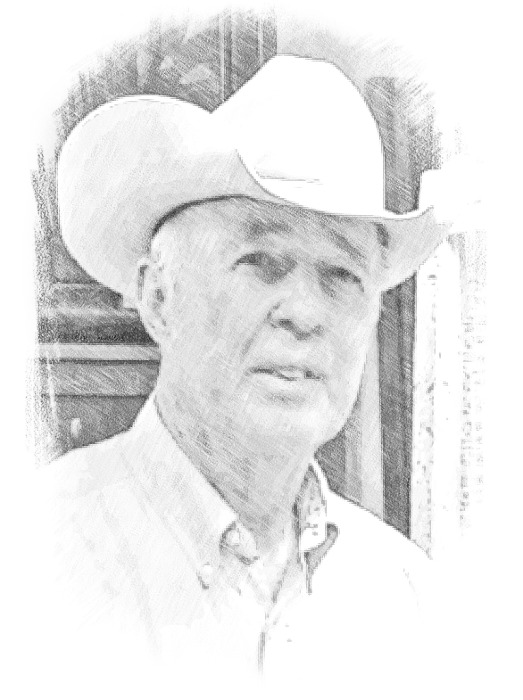
Wayne Baize, CA
(b. 1943)
Wayne Baize depicts the contemporary cowboy and gives honor to the cowboy way of life. He received the Western Artist of the Year Award from the Academy of Western Artists in 2000 and in 2004, he won the American Cowboy Culture Award for Western Art. He was awarded the CA Silver Medal for Drawing in 1997.
In the 2013 CA show, Wayne won the TCAA Award for his piece Managing Men, Land and Cattle.
Being a member of the Cowboy Artists of America has been the highest honor of his professional career. He was elected to membership in 1995 and served as vice president and director prior to becoming president of the organization in 2006–2007.
His work is shown at Midland Gallery in Midland, Texas, and Trailside Galleries in Jackson, Wyoming, and Scottsdale, Arizona.
Source: Cowboy Artists of America
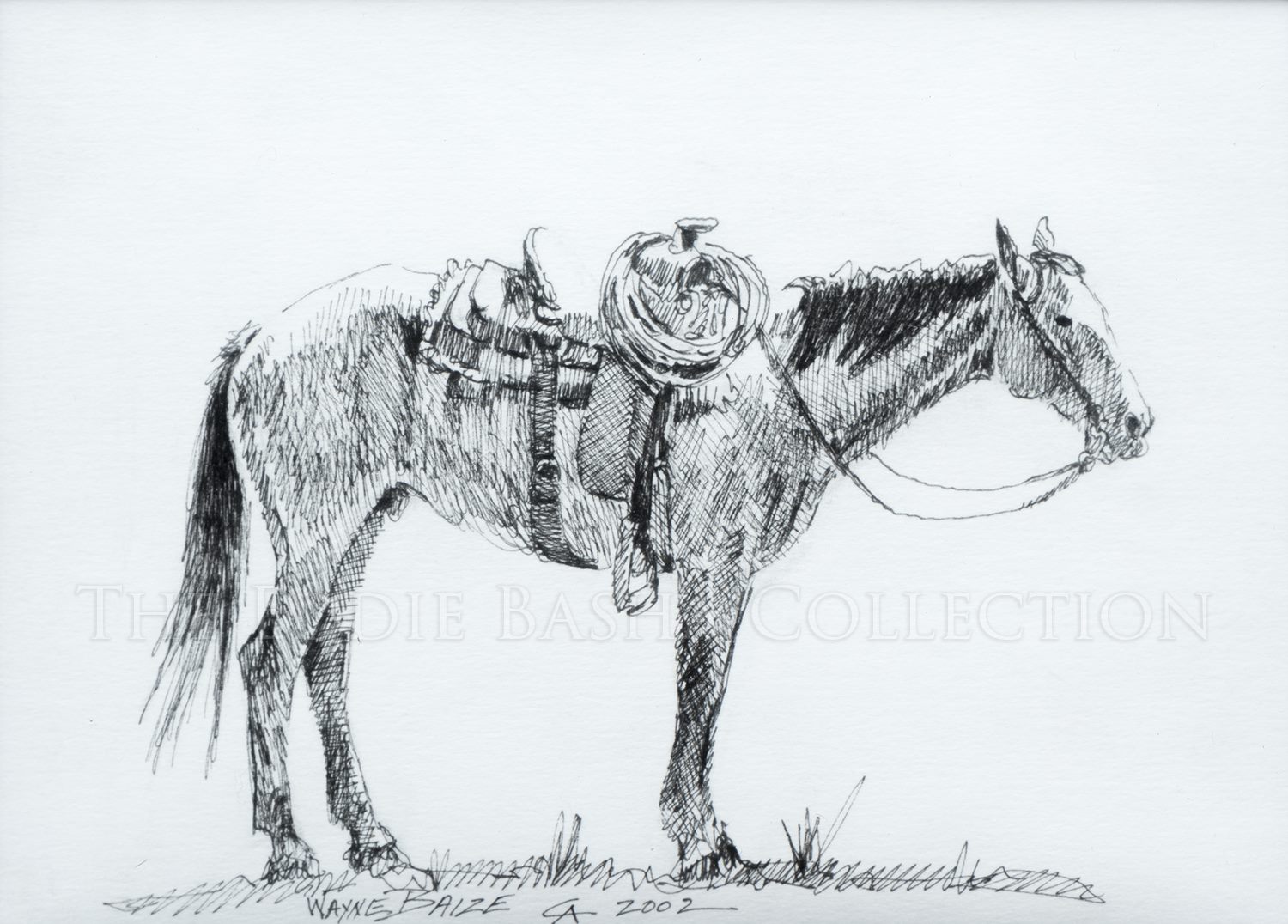
Unknown Title
Artist: Wayne Baize, CA (b. 1943)
Description: Pen & Ink (2002) | Image Size: 5”h x 7”w; Framed Size: 12 ¼” h x 14”wdrawing
Wayne Baize drew this cow horse, saddled and ready for a day’s work. It is a highly accurate rendition of the type of horse that Baize uses in his own ranch work in West Texas where he and his wife raised their family and run a small herd of registered Hereford cattle.
Baize became a member of the Cowboy Artists of America in 1995, fulfilling a dream but also serving as a challenge to become a better artist. And since that time, he’s risen to the challenge and has been rewarded for doing so. The many honors and accolades he has received are numerous and his masterworks have been featured in several publications such as Western Horseman, The Cattleman, The American Quarter Horse Journal, The Herford Journal and Texas Monthly. Baize continues to pursue his passion and commitment in carrying out the CAA mission to “authentically preserve and perpetuate the culture of Western life in fine art.”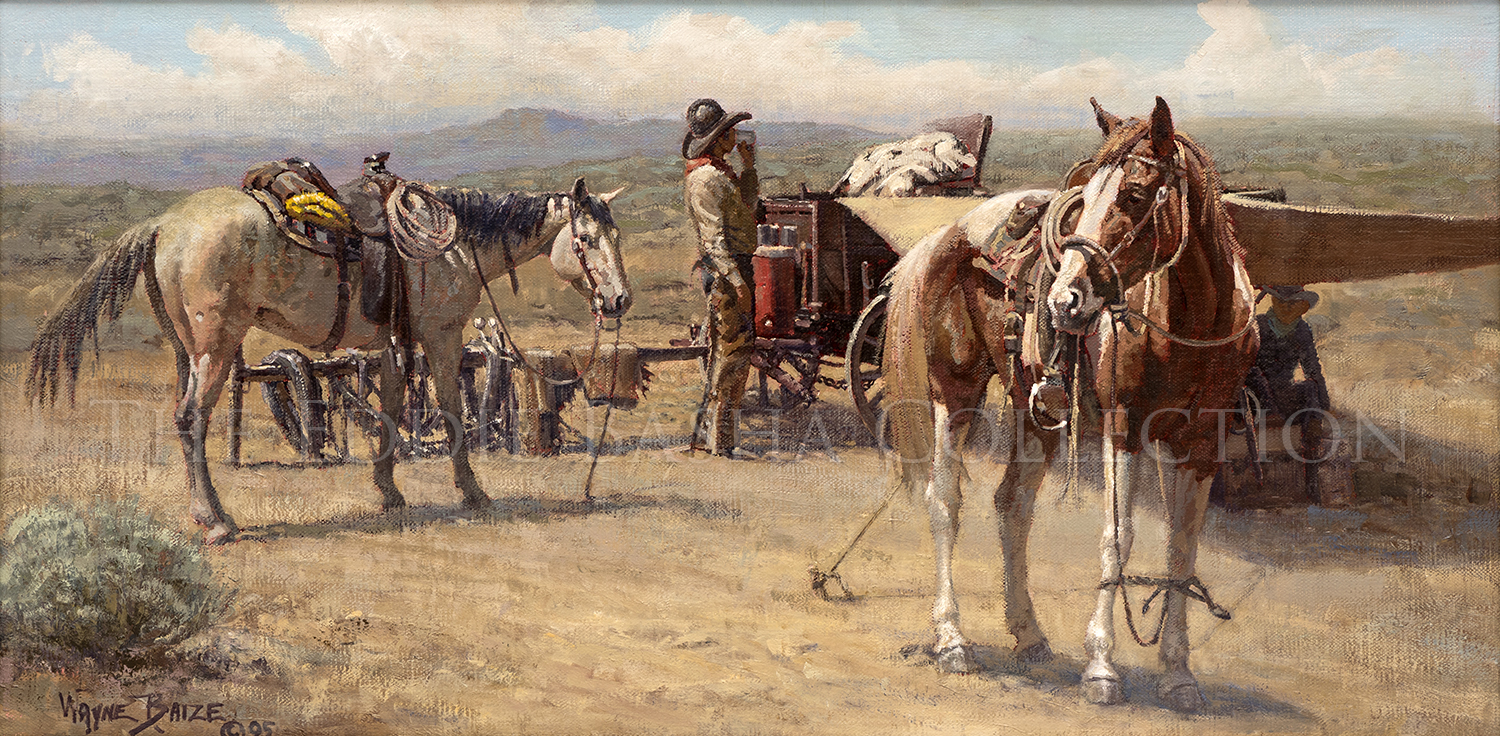
A Dry, Thirsty Land
Artist: Wayne Baize, CA (b. 1943)
Description: Oil (1995) | Image Size: 12”h x 24”w; Framed Size: 23 ¼”h x 35 ¼”wpainting
Similar to other of Wayne Baize’s paintings, this one depicts a typical day in the life of a modern cowboy. In this case, the work on a contemporary ranch is much the same as it was in the nineteenth century. The days are long, the work hard, and the land is demanding. Baize uses two horses to bracket the painting, the one nearest the viewer is hobbled. One cowboy drinks from a water cooler, one of the only hints of modern times, while another rests in the shade of a canvas staked to the wagon.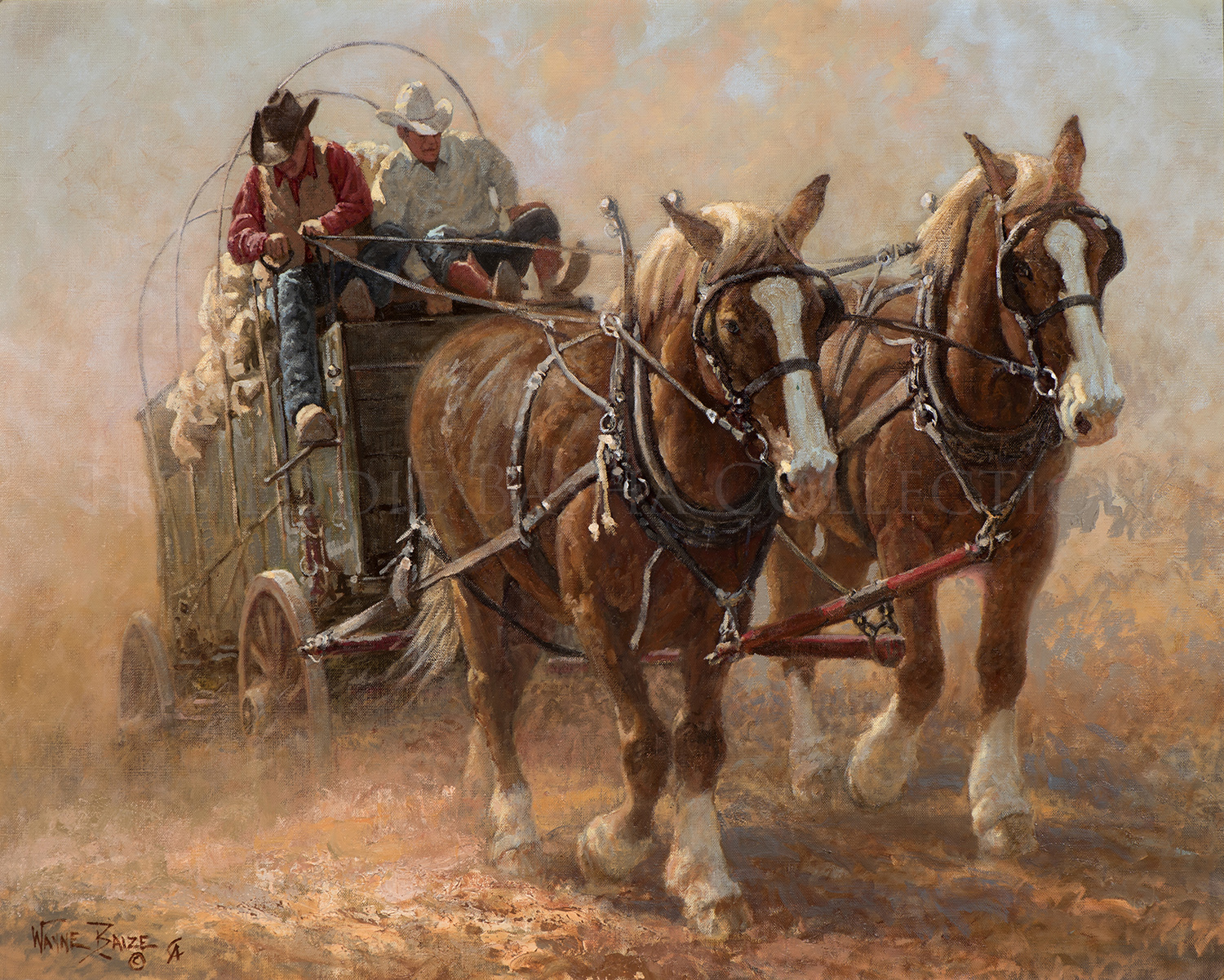
Slow Pull
Artist: Wayne Baize, CA (b. 1943)
Description: Oil (2009) | Image Size: 24”h x 30”w; Framed Size: 35”h x 41”wpainting
Wayne Baize spent much of his early time as an artist painting and drawing horses. In “Slow Pull”, the attention is squarely focused on the two large draft horses that are walking toward the viewer. They are pictured in great detail and high contrast to the background which further accentuates Baize’s expertise. The clarity of the figures and the overall scene fades as the viewer’s eye travels from horse to riders to the dust kicked up by the wagon wheels thus reinforcing the horses’ role as the paintings primary subjects. This painting made its debut at the 44th Annual Cowboy Artists of America Exhibition & Sale in 2009 at the Phoenix Art Museum.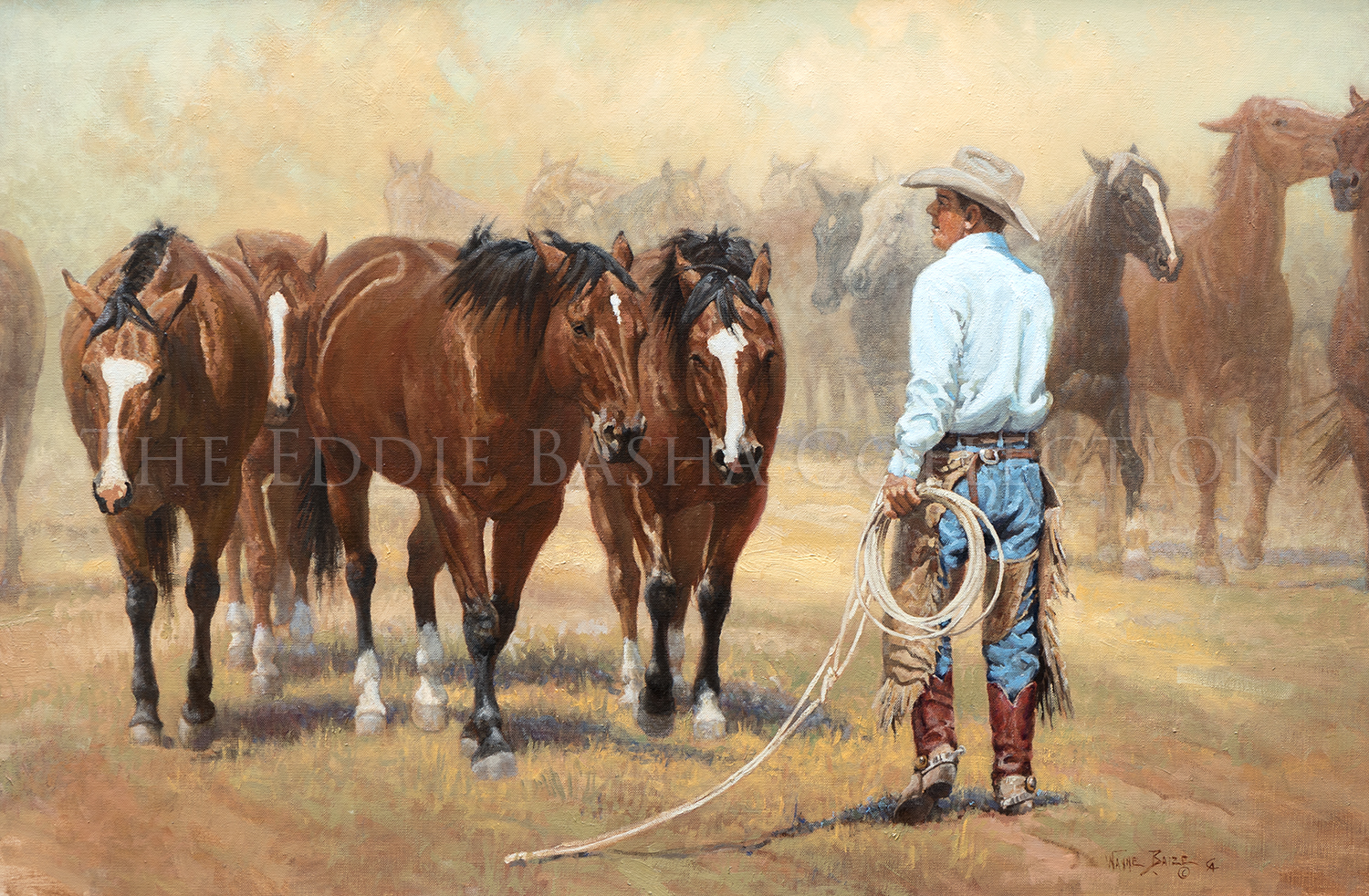
Lookin’ for His Mount
Artist: Wayne Baize, CA (b. 1943)
Description: Oil (2002) | Image Size: 24”h x 36”w; Framed Size: 34”h x 46”wpainting
In this painting by Wayne Baize, a cowboy with lariat in hand, prepares to begin what will likely be a long day by selecting the horse he will ride. Baize places the cowboy, wearing a pale blue shirt that reflects the morning sun, in the middle of the remuda with four horses nearby and several others milling about in the background somewhat obscured by a rising dust cloud. Light is reflected off of the dust particles as well as the white spots on the horses’ faces, and the cowhand’s clothes. Baize has perfectly captured the feeling of anticipation that unfolds just as the work day is about to begin.
This piece debuted at the 37th Annual Cowboy Artists of America Sale & Exhibition held in 2002 at the Phoenix Art Museum and was subsequently exhibited at the “Cowboy Artists of America: The 50-Year Roundup” at the Sedona Arts Center in 2015.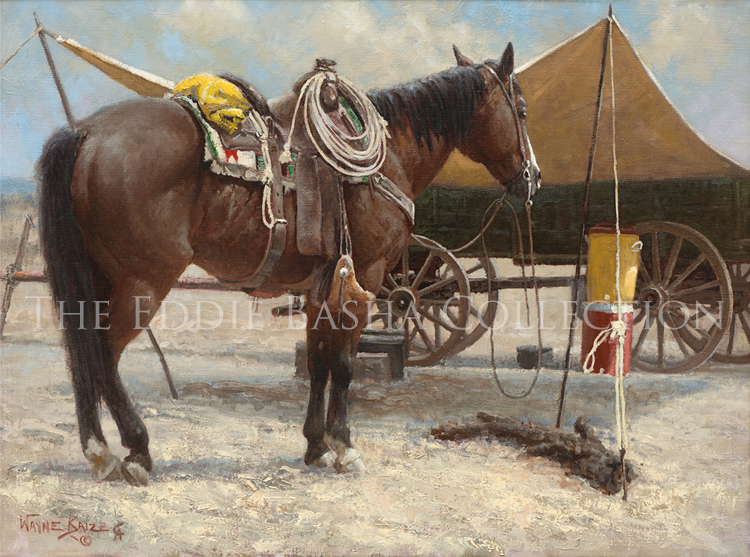
Sand and Dust on Salt Flat
Artist: Wayne Baize, CA (b. 1943)
Description: Oil | Image Size: 18”h x 24”w; Framed Size: 26 3/8”h x 32 3/8”wpainting
This very well executed painting of a cow horse tethered near a canvas shaded wagon on the Salt Flats is an excellent example of Cowboy Artists of America member Wayne Baize’s ability to realistically depict horses, the environments in which they work, and the gear that is needed by present day cowhands. The horse is shown decked out with a saddle, blanket, lariat, and a rolled up yellow slicker. The nearby wagon, canvas shade and feed buckets have an equal air of authenticity as does the surrounding parched flat terrain. We have a sense that at any moment the rider will return to continue his day’s work.
As shared by the National Park Service Website: “Upon approaching the Guadalupe Mountains from the west, visitors traveling from the El Paso area will pass through a landscape of barren beauty. The Salt Flats are a remnant of an ancient, shallow lake that once occupied this area during the Pleistocene Epoch, approximately 1.8 million years ago. Salt collected here as streams drained mineral-laden water into this basin. The basin, called a graben, formed about 26 million years ago as faulting lifted the Guadalupe Mountains and depressed the adjacent block of the Earth’s crust. At the end of the last ice age, approximately 10,000 years ago, the lake dried up as the climate became more arid. The salt deposits left behind would later become a precious resource to the people of the El Paso area.”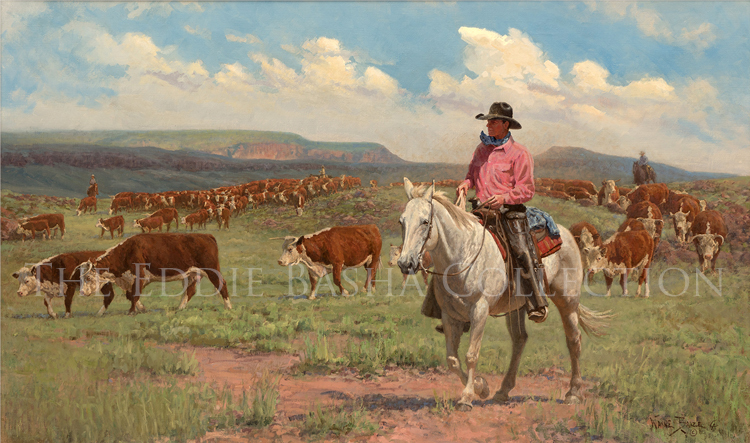
Highland Roundup
Artist: Wayne Baize, CA (b. 1943)
Description: Oil | Image Size: 24”h x 40”w; Framed Size: 33 3/8”h x 49 3/8”wpainting
Wayne Baize is well known for paintings that show the everyday work on a modern ranch. Some of that work has remained constant from historic periods to today—cattle must still be rounded up for branding, or moved to seasonal pastures. Baize, who lives with his family on a ranch in far West Texas in the Davis Mountains, knows this life well. His work in the saddle informs his work in the studio.
Here a cowboy on a striking white horse is engaged in moving cattle across a large expanse of pasture. Other cowboys are shown in the background moving another portion of the herd. The work is done under a brilliant Texas sky dotted with white clouds that offer a bit of shade to both the men and the animals. The scene is set in the early afternoon, and Baize has effectively used the sunlight to highlight the white horse. The action of the painting moves from right to left with the viewer’s eye focused on the figure of the cowboy in the right foreground.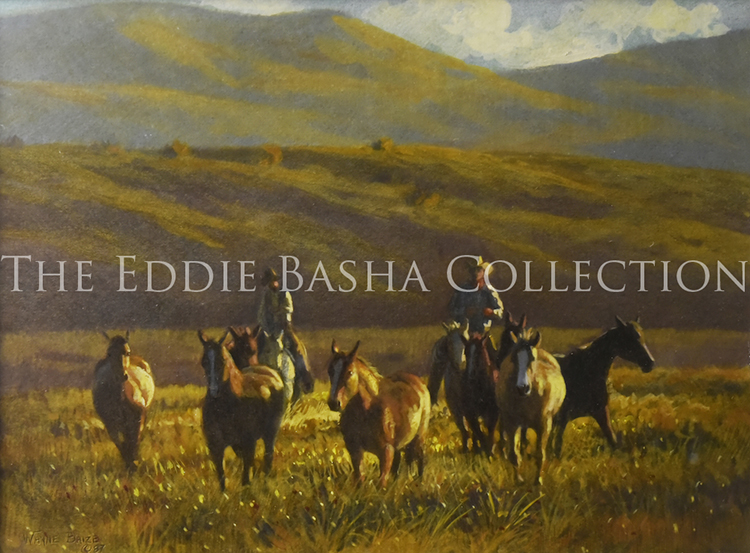
Good to be Alive
Artist: Wayne Baize, CA (b. 1943)
Description: Mixed Media (1987) | Image Size: 9”h x 12”w; Framed Size: 19 ¼”h x 22 ½”wpainting
Once again Wayne Baize managed to imbue both energy and a sense of place in a small image. Surrounded by pristine landscape, cowboys and horses lope toward the viewer. The scene is set in the Davis Mountains in far West Texas, home to the Baize family ranch. The joy of living and working in this beautiful environment is clearly communicated in this piece.
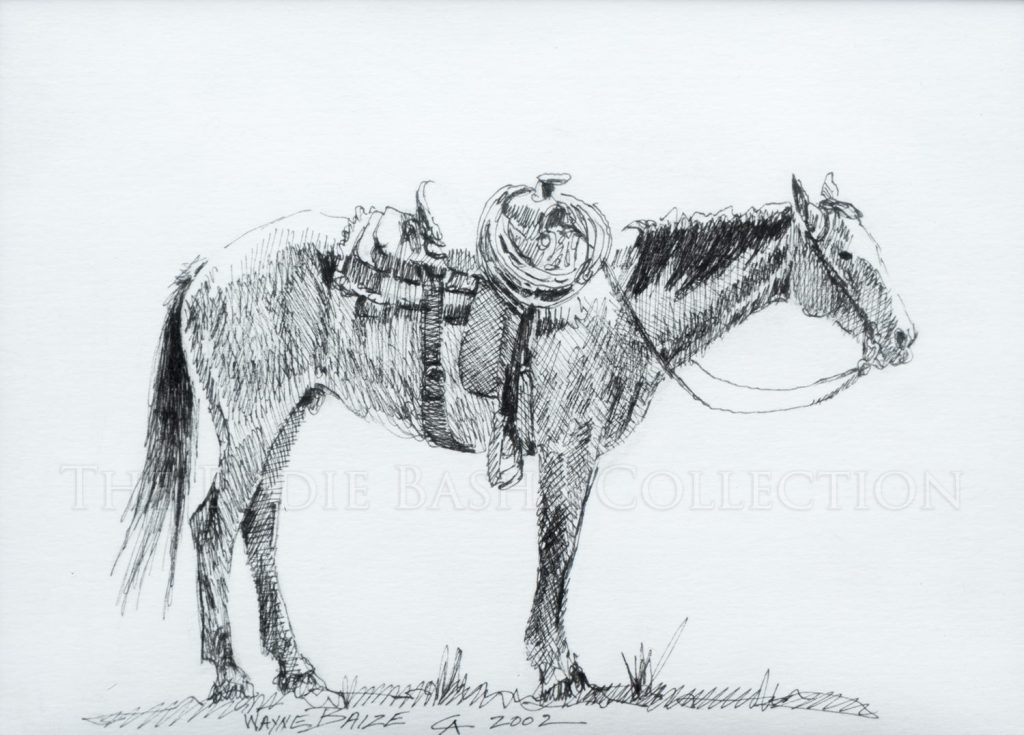 Pen & Ink (2002) | Image Size: 5”h x 7”w; Framed Size: 12 ¼” h x 14”w
Pen & Ink (2002) | Image Size: 5”h x 7”w; Framed Size: 12 ¼” h x 14”w Wayne Baize drew this cow horse, saddled and ready for a day’s work. It is a highly accurate rendition of the type of horse that Baize uses in his own ranch work in West Texas where he and his wife raised their family and run a small herd of registered Hereford cattle.
Baize became a member of the Cowboy Artists of America in 1995, fulfilling a dream but also serving as a challenge to become a better artist. And since that time, he’s risen to the challenge and has been rewarded for doing so. The many honors and accolades he has received are numerous and his masterworks have been featured in several publications such as Western Horseman, The Cattleman, The American Quarter Horse Journal, The Herford Journal and Texas Monthly. Baize continues to pursue his passion and commitment in carrying out the CAA mission to “authentically preserve and perpetuate the culture of Western life in fine art.”
Unknown Title
Artist: Wayne Baize, CA (b. 1943)
Wayne Baize drew this cow horse, saddled and ready for a day’s work. It is a highly accurate rendition of the type of horse that Baize uses in his own ranch work in West Texas where he and his wife raised their family and run a small herd of registered Hereford cattle.
Baize became a member of the Cowboy Artists of America in 1995, fulfilling a dream but also serving as a challenge to become a better artist. And since that time, he’s risen to the challenge and has been rewarded for doing so. The many honors and accolades he has received are numerous and his masterworks have been featured in several publications such as Western Horseman, The Cattleman, The American Quarter Horse Journal, The Herford Journal and Texas Monthly. Baize continues to pursue his passion and commitment in carrying out the CAA mission to “authentically preserve and perpetuate the culture of Western life in fine art.”
 Oil (1995) | Image Size: 12”h x 24”w; Framed Size: 23 ¼”h x 35 ¼”w
Oil (1995) | Image Size: 12”h x 24”w; Framed Size: 23 ¼”h x 35 ¼”wSimilar to other of Wayne Baize’s paintings, this one depicts a typical day in the life of a modern cowboy. In this case, the work on a contemporary ranch is much the same as it was in the nineteenth century. The days are long, the work hard, and the land is demanding. Baize uses two horses to bracket the painting, the one nearest the viewer is hobbled. One cowboy drinks from a water cooler, one of the only hints of modern times, while another rests in the shade of a canvas staked to the wagon.
A Dry, Thirsty Land
Artist: Wayne Baize, CA (b. 1943)
Similar to other of Wayne Baize’s paintings, this one depicts a typical day in the life of a modern cowboy. In this case, the work on a contemporary ranch is much the same as it was in the nineteenth century. The days are long, the work hard, and the land is demanding. Baize uses two horses to bracket the painting, the one nearest the viewer is hobbled. One cowboy drinks from a water cooler, one of the only hints of modern times, while another rests in the shade of a canvas staked to the wagon.
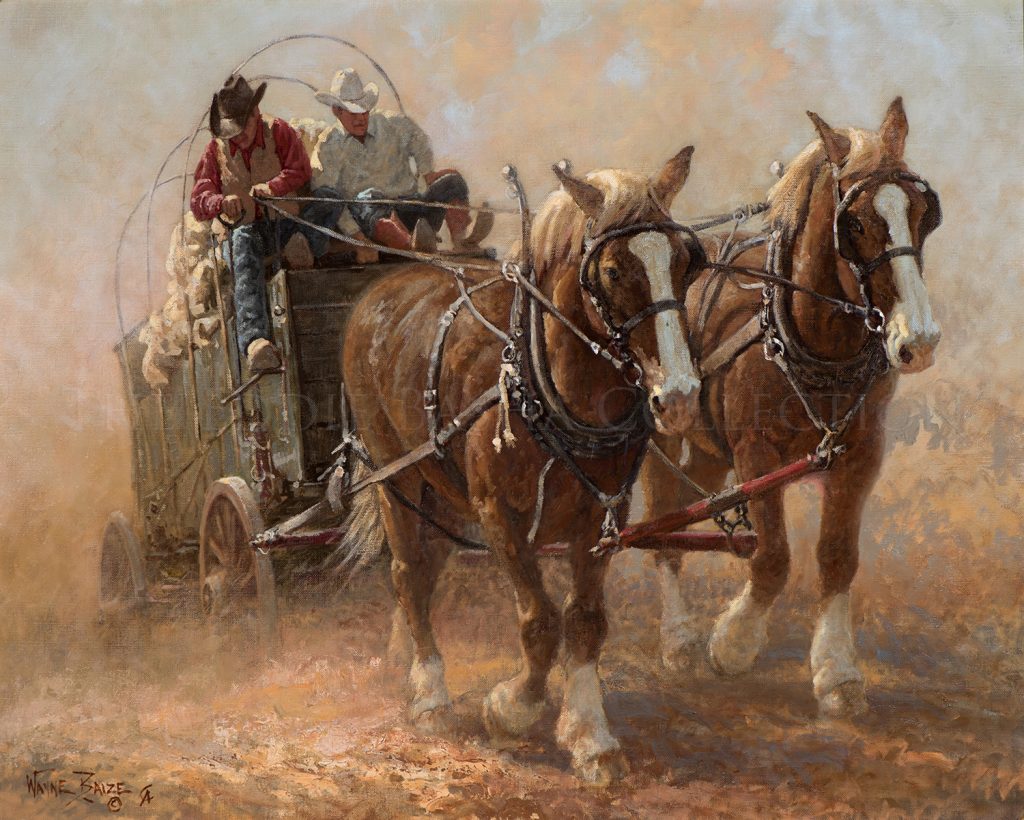 Oil (2009) | Image Size: 24”h x 30”w; Framed Size: 35”h x 41”w
Oil (2009) | Image Size: 24”h x 30”w; Framed Size: 35”h x 41”wWayne Baize spent much of his early time as an artist painting and drawing horses. In “Slow Pull”, the attention is squarely focused on the two large draft horses that are walking toward the viewer. They are pictured in great detail and high contrast to the background which further accentuates Baize’s expertise. The clarity of the figures and the overall scene fades as the viewer’s eye travels from horse to riders to the dust kicked up by the wagon wheels thus reinforcing the horses’ role as the paintings primary subjects. This painting made its debut at the 44th Annual Cowboy Artists of America Exhibition & Sale in 2009 at the Phoenix Art Museum.
Slow Pull
Artist: Wayne Baize, CA (b. 1943)
Wayne Baize spent much of his early time as an artist painting and drawing horses. In “Slow Pull”, the attention is squarely focused on the two large draft horses that are walking toward the viewer. They are pictured in great detail and high contrast to the background which further accentuates Baize’s expertise. The clarity of the figures and the overall scene fades as the viewer’s eye travels from horse to riders to the dust kicked up by the wagon wheels thus reinforcing the horses’ role as the paintings primary subjects. This painting made its debut at the 44th Annual Cowboy Artists of America Exhibition & Sale in 2009 at the Phoenix Art Museum.
 Oil (2002) | Image Size: 24”h x 36”w; Framed Size: 34”h x 46”w
Oil (2002) | Image Size: 24”h x 36”w; Framed Size: 34”h x 46”wIn this painting by Wayne Baize, a cowboy with lariat in hand, prepares to begin what will likely be a long day by selecting the horse he will ride. Baize places the cowboy, wearing a pale blue shirt that reflects the morning sun, in the middle of the remuda with four horses nearby and several others milling about in the background somewhat obscured by a rising dust cloud. Light is reflected off of the dust particles as well as the white spots on the horses’ faces, and the cowhand’s clothes. Baize has perfectly captured the feeling of anticipation that unfolds just as the work day is about to begin.
This piece debuted at the 37th Annual Cowboy Artists of America Sale & Exhibition held in 2002 at the Phoenix Art Museum and was subsequently exhibited at the “Cowboy Artists of America: The 50-Year Roundup” at the Sedona Arts Center in 2015.
Lookin’ for His Mount
Artist: Wayne Baize, CA (b. 1943)
In this painting by Wayne Baize, a cowboy with lariat in hand, prepares to begin what will likely be a long day by selecting the horse he will ride. Baize places the cowboy, wearing a pale blue shirt that reflects the morning sun, in the middle of the remuda with four horses nearby and several others milling about in the background somewhat obscured by a rising dust cloud. Light is reflected off of the dust particles as well as the white spots on the horses’ faces, and the cowhand’s clothes. Baize has perfectly captured the feeling of anticipation that unfolds just as the work day is about to begin.
This piece debuted at the 37th Annual Cowboy Artists of America Sale & Exhibition held in 2002 at the Phoenix Art Museum and was subsequently exhibited at the “Cowboy Artists of America: The 50-Year Roundup” at the Sedona Arts Center in 2015.
 Oil | Image Size: 18”h x 24”w; Framed Size: 26 3/8”h x 32 3/8”w
Oil | Image Size: 18”h x 24”w; Framed Size: 26 3/8”h x 32 3/8”wThis very well executed painting of a cow horse tethered near a canvas shaded wagon on the Salt Flats is an excellent example of Cowboy Artists of America member Wayne Baize’s ability to realistically depict horses, the environments in which they work, and the gear that is needed by present day cowhands. The horse is shown decked out with a saddle, blanket, lariat, and a rolled up yellow slicker. The nearby wagon, canvas shade and feed buckets have an equal air of authenticity as does the surrounding parched flat terrain. We have a sense that at any moment the rider will return to continue his day’s work.
As shared by the National Park Service Website: “Upon approaching the Guadalupe Mountains from the west, visitors traveling from the El Paso area will pass through a landscape of barren beauty. The Salt Flats are a remnant of an ancient, shallow lake that once occupied this area during the Pleistocene Epoch, approximately 1.8 million years ago. Salt collected here as streams drained mineral-laden water into this basin. The basin, called a graben, formed about 26 million years ago as faulting lifted the Guadalupe Mountains and depressed the adjacent block of the Earth’s crust. At the end of the last ice age, approximately 10,000 years ago, the lake dried up as the climate became more arid. The salt deposits left behind would later become a precious resource to the people of the El Paso area.”
Sand and Dust on Salt Flat
Artist: Wayne Baize, CA (b. 1943)
This very well executed painting of a cow horse tethered near a canvas shaded wagon on the Salt Flats is an excellent example of Cowboy Artists of America member Wayne Baize’s ability to realistically depict horses, the environments in which they work, and the gear that is needed by present day cowhands. The horse is shown decked out with a saddle, blanket, lariat, and a rolled up yellow slicker. The nearby wagon, canvas shade and feed buckets have an equal air of authenticity as does the surrounding parched flat terrain. We have a sense that at any moment the rider will return to continue his day’s work.
As shared by the National Park Service Website: “Upon approaching the Guadalupe Mountains from the west, visitors traveling from the El Paso area will pass through a landscape of barren beauty. The Salt Flats are a remnant of an ancient, shallow lake that once occupied this area during the Pleistocene Epoch, approximately 1.8 million years ago. Salt collected here as streams drained mineral-laden water into this basin. The basin, called a graben, formed about 26 million years ago as faulting lifted the Guadalupe Mountains and depressed the adjacent block of the Earth’s crust. At the end of the last ice age, approximately 10,000 years ago, the lake dried up as the climate became more arid. The salt deposits left behind would later become a precious resource to the people of the El Paso area.”
 Oil | Image Size: 24”h x 40”w; Framed Size: 33 3/8”h x 49 3/8”w
Oil | Image Size: 24”h x 40”w; Framed Size: 33 3/8”h x 49 3/8”wWayne Baize is well known for paintings that show the everyday work on a modern ranch. Some of that work has remained constant from historic periods to today—cattle must still be rounded up for branding, or moved to seasonal pastures. Baize, who lives with his family on a ranch in far West Texas in the Davis Mountains, knows this life well. His work in the saddle informs his work in the studio.
Here a cowboy on a striking white horse is engaged in moving cattle across a large expanse of pasture. Other cowboys are shown in the background moving another portion of the herd. The work is done under a brilliant Texas sky dotted with white clouds that offer a bit of shade to both the men and the animals. The scene is set in the early afternoon, and Baize has effectively used the sunlight to highlight the white horse. The action of the painting moves from right to left with the viewer’s eye focused on the figure of the cowboy in the right foreground.
Highland Roundup
Artist: Wayne Baize, CA (b. 1943)
Wayne Baize is well known for paintings that show the everyday work on a modern ranch. Some of that work has remained constant from historic periods to today—cattle must still be rounded up for branding, or moved to seasonal pastures. Baize, who lives with his family on a ranch in far West Texas in the Davis Mountains, knows this life well. His work in the saddle informs his work in the studio.
Here a cowboy on a striking white horse is engaged in moving cattle across a large expanse of pasture. Other cowboys are shown in the background moving another portion of the herd. The work is done under a brilliant Texas sky dotted with white clouds that offer a bit of shade to both the men and the animals. The scene is set in the early afternoon, and Baize has effectively used the sunlight to highlight the white horse. The action of the painting moves from right to left with the viewer’s eye focused on the figure of the cowboy in the right foreground.
 Mixed Media (1987) | Image Size: 9”h x 12”w; Framed Size: 19 ¼”h x 22 ½”w
Mixed Media (1987) | Image Size: 9”h x 12”w; Framed Size: 19 ¼”h x 22 ½”wOnce again Wayne Baize managed to imbue both energy and a sense of place in a small image. Surrounded by pristine landscape, cowboys and horses lope toward the viewer. The scene is set in the Davis Mountains in far West Texas, home to the Baize family ranch. The joy of living and working in this beautiful environment is clearly communicated in this piece.
Good to be Alive
Artist: Wayne Baize, CA (b. 1943)
Once again Wayne Baize managed to imbue both energy and a sense of place in a small image. Surrounded by pristine landscape, cowboys and horses lope toward the viewer. The scene is set in the Davis Mountains in far West Texas, home to the Baize family ranch. The joy of living and working in this beautiful environment is clearly communicated in this piece.